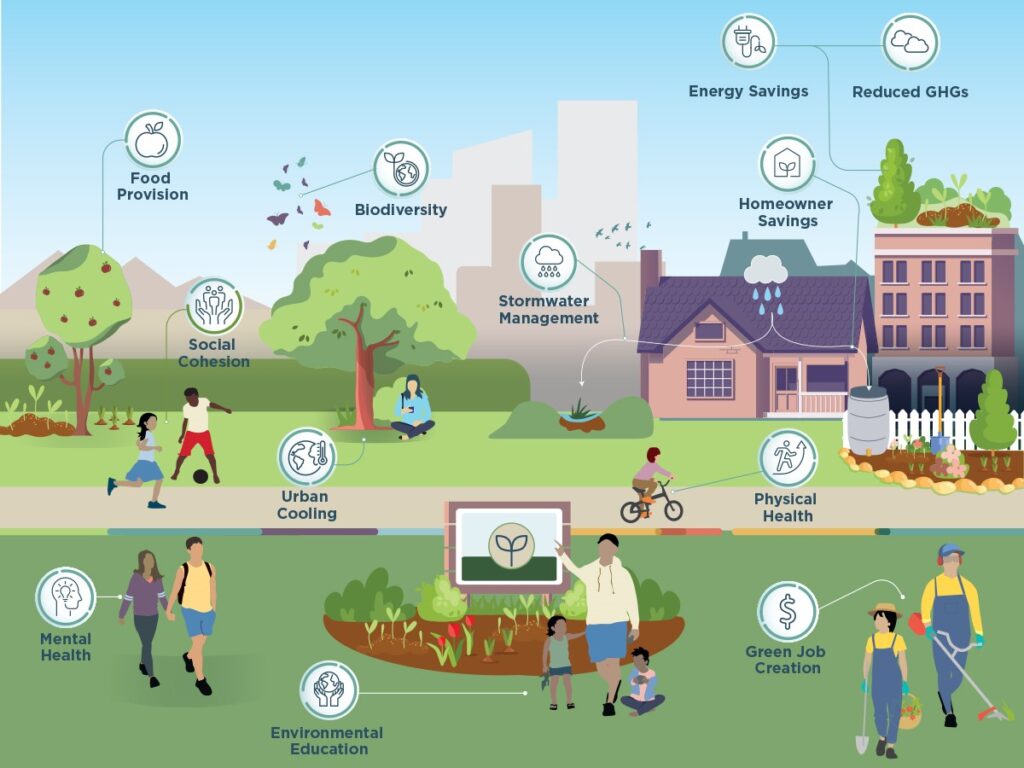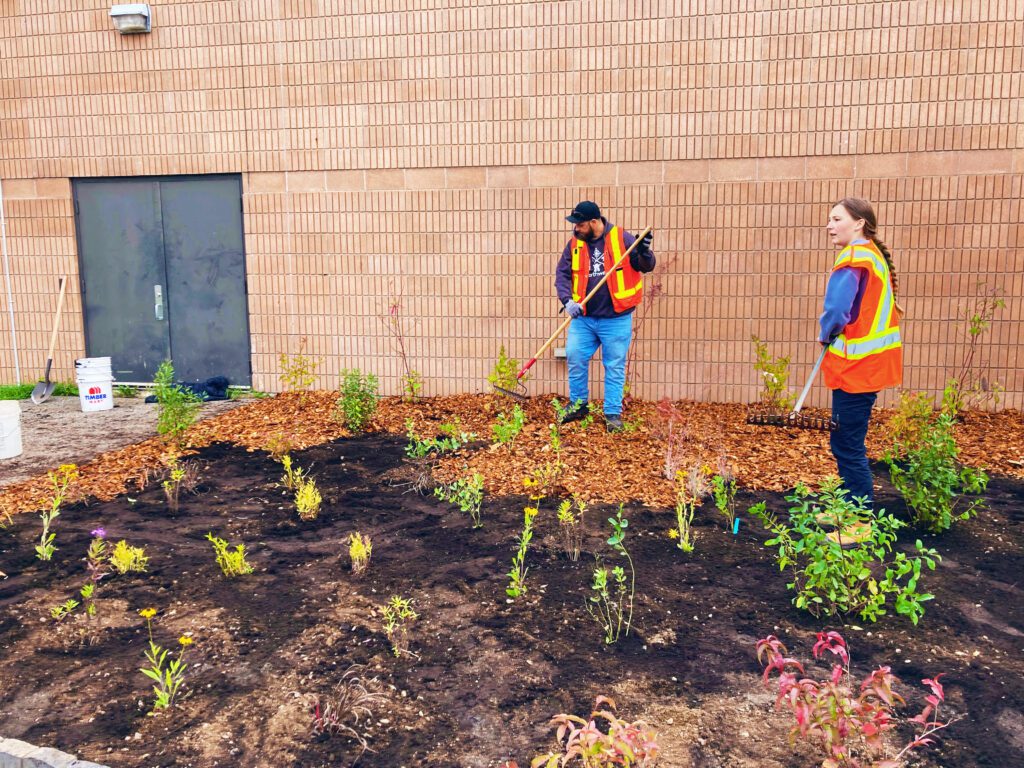Living Cities Canada is significantly scaling up its impact in 2023 and 2024 with the launch of the Living Cities Canada Fund. The Fund — which has two streams — will support local partner organizations across Canada to create new green infrastructure in their communities.
In February, Green Communities Canada (GCC) announced the ‘Transform Stream’ and the 11 partner organizations we are supporting to design and create large-scale, equity-embedded green infrastructure in their communities.
Green Communities Canada is now announcing funding and support for 13 partner organizations through the ‘Demonstrate Stream’, which facilitates smaller-scale, community-led green infrastructure projects across the country.
“We are so excited to support so many amazing organizations across the country to create vibrant and equitable green spaces in their communities,” says Brianna Salmon, GCC’s Executive Director. “The Living Cities Canada Fund builds upon our existing green infrastructure programs, like Depave Paradise and our National Mini Forests Pilot, empowering a broader cohort with the resources, tools and skills to build more climate-resilient and socially just neighbourhoods.”
The first project funded through the Demonstrate Stream will take place on May 23, 2022, with the creation of a native plant garden at the headquarters of Waterloo-based Definity Insurance, who is a major contributor to the Living Cities Canada Fund. Green Communities Canada staff will be on site, along with Definity employees and Kitchener-Waterloo-based Reep Green Solutions, who is overseeing the creation of the new gardens.
Other projects funded through the Demonstrate Stream include:
- A mini forest in Langley, BC led by Langley Environmental Partners Society
- A re-naturalization project on the lands of the Ashcroft Indian Band in Interior BC
- A mini forest in Calgary, AB led by Calgary Climate Hub
- A mini forest in Kingston, ON led by Little Forests Kingston
- A mini forest in Georgetown, ON led by Credit Valley Conservation
- A pollinator garden in Toronto, ON led by Scadding Court Community Centre
- A rain garden in Ottawa, ON led by the Rhoda Foundation
- A mini forest in Toronto, ON led by RAINscape TO
- A mini forest in Oakville, ON led by Oakvillegreen Conservation Association
- A depave in Sherbrooke, QC led by REVE Nourricier
- A mini forest in Moncton, NB led by Fundy Biosphere Region
These projects will be created in diverse locations, like at community centres, in Indigenous communities and cultural sites, at social housing complexes, at a mosque, at schools and more.
In total, the Living Cities Canada Fund will support the creation of 28 community-led green infrastructure projects across Canada in 2023-24. These projects will engage hundreds of community members to collectively create nearly 5,000m2 of new urban green spaces in seven different provinces.

Creation of new green spaces through the Living Cities Canada Program will have many benefits to communities, including reducing exposure to extreme heat, urban flooding, and other climate-related extremes; providing municipal services like stormwater management in a cost-effective way; supporting biodiversity; improving air quality; and boosting the physical and mental well-being of local residents.
These projects accelerate Living Cities Canada’s vision of advancing equitable, abundant, and thriving green infrastructure in communities across the country.
Here’s how the Living Cities Canada Fund helps to realize that vision.
Building Community Capacity and Leadership for Green Infrastructure from the Bottom-Up
In our Pathways to Living Cities Framework, we laid out the importance of engaging and involving community to bring about green infrastructure. Some important reasons for this are:
- Green infrastructure is most effective when it is employed widely across the landscape. Since most lands in cities are privately owned, green infrastructure cannot just be a “top-down” strategy led by governments. Local residents and businesses must be part of the solution by creating and stewarding projects.
- Community engagement is crucial to ensuring green infrastructure is equitable. This requires bringing together diverse voices and giving space for those who are most impacted to co-create green infrastructure.
Community organizations are excellent connectors and mobilizers. They are typically embedded in the communities they work in, are more likely to be considered trustworthy, and can engage with residents in more nimble and flexible ways.
“That’s why Living Cities Canada is supporting local organizations across Canada to engage and mobilize community members to create new green infrastructure. We know that when we give these organizations funding, training, tools, and networks of support to create new green infrastructure, they will share this knowledge and resources with other members of their communities, empowering a groundswell of local leaders across the country to advocate for and create green infrastructure,” says Christine Mettler, Green Communities Canada’s the Green Infrastructure Program Director.

Volunteers engaged in a planting event organized by Ecosuperior through the Depave Paradise program
Our Living Cities Canada Fund is designed to meet community organizations where they are at, helping them to start small, learn through practice, and then increase their impact. The two streams that Green Communities Canada is focusing on this year are:
- Demonstrate Stream – Designed for community organizations that are newer to creating green infrastructure projects, wish to create smaller-scale (~100m2) projects, and/or are in the early stages of building partnerships to support implementation. Projects that serve and/or involve equity-deserving groups are prioritized. This stream offers participants access to standardized training modules, tools, templates, and coaching to support projects.
- Transform Stream – Designed for community organizations that have experience creating green infrastructure in their communities (e.g. having completed a number of Depave Paradise events, rain gardens and/or mini forests). Participants are in a cohort and complete customized equity training together, participate in a community of practice, and follow a structured process to implement larger-scale (>250m2), equity-embedded green infrastructure projects in collaboration with community members and organizations.
Centering equity in green infrastructure

Kids planting at an event in Winnipeg led by Green Action Centre
One of the key pillars of the Living Cities Canada program is to create equitable green infrastructure. That’s because not everyone has the same access to green infrastructure or its benefits. Analyses of municipalities, including Canadian communities, have found that low-income neighbourhoods and communities with higher proportions of visible minorities and newcomers are more likely to have fewer green spaces, compounding the social and health inequities.
The Living Cities Canada program is working to build supports and structured processes to help community organizations embed equity into green infrastructure. Participants of the “Transform Stream” participate in a 10-part equity training series where they learn about equity mapping, participatory planning tactics, and integrating anti-oppressive approaches into community engagement.
“We do not want Transform Stream projects to come to this program knowing what they’re going to do and where they’re going to implement it. We want that process to be shaped in conversation with equity-deserving groups and the organizations that serve them,” says Mettler.
Green Communities Canada is collaborating with academic partners from the Dalla Lana School of Public Health (University of Toronto) and the University of Waterloo to create custom equity maps for each participating community. These maps will show where environmental and social risk intersect, based on census and environmental data.
Our partner organizations will use this data to prioritize neighborhoods where green infrastructure is needed the most, and then work with community organizations that serve those neighbourhoods to understand the needs and desires of local residents and how green infrastructure can help address those.
Together, these projects will help transform Canadian cities and town into resilient, equitable, climate-ready communities.
These projects are possible thanks to funding from multiple funders including the TD Ready Commitment, Definity Insurance Foundation, the Green Belt Foundation, and the All One Fund.
Follow us on Facebook, LinkedIn, Twitter or Instagram to stay informed about Living Cities Canada events happening through the year.

Trackbacks/Pingbacks